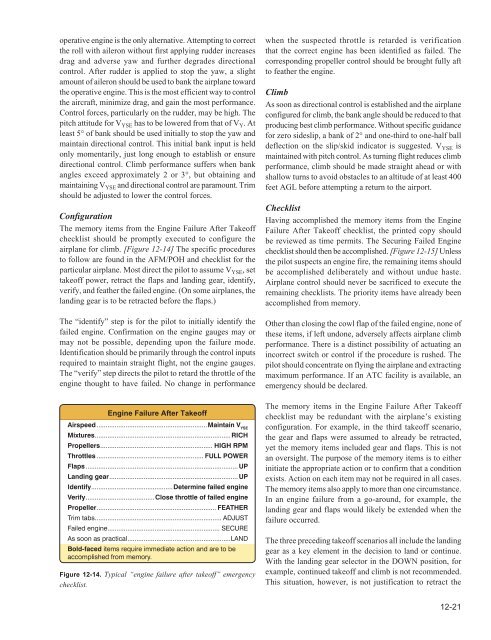Create successful ePaper yourself
Turn your PDF publications into a flip-book with our unique Google optimized e-Paper software.
operative engine is the only alternative. Attempting to correct<br />
the roll with aileron without first applying rudder increases<br />
drag and adverse yaw and further degrades directional<br />
control. After rudder is applied to stop the yaw, a slight<br />
amount of aileron should be used to bank the airplane toward<br />
the operative engine. This is the most efficient way to control<br />
the aircraft, minimize drag, and gain the most performance.<br />
Control forces, particularly on the rudder, may be high. The<br />
pitch attitude for V YSE has to be lowered from that of V Y . At<br />
least 5° of bank should be used initially to stop the yaw and<br />
maintain directional control. This initial bank input is held<br />
only momentarily, just long enough to establish or ensure<br />
directional control. Climb performance suffers when bank<br />
angles exceed approximately 2 or 3°, but obtaining and<br />
maintaining V YSE and directional control are paramount. Trim<br />
should be adjusted to lower the control forces.<br />
Configuration<br />
The memory items from the Engine Failure After Takeoff<br />
checklist should be promptly executed to configure the<br />
airplane for climb. [Figure 12-14] The specific procedures<br />
to follow are found in the AFM/POH and checklist for the<br />
particular airplane. Most direct the pilot to assume V YSE , set<br />
takeoff power, retract the flaps and landing gear, identify,<br />
verify, and feather the failed engine. (On some airplanes, the<br />
landing gear is to be retracted before the flaps.)<br />
The “identify” step is for the pilot to initially identify the<br />
failed engine. Confirmation on the engine gauges may or<br />
may not be possible, depending upon the failure mode.<br />
Identification should be primarily through the control inputs<br />
required to maintain straight flight, not the engine gauges.<br />
The “verify” step directs the pilot to retard the throttle of the<br />
engine thought to have failed. No change in performance<br />
Engine Failure After Takeoff<br />
Airspeed .............................................................Maintain V YSE<br />
Mixtures...........................................................................RICH<br />
Propellers.............................................................. HIGH RPM<br />
Throttles ........................................................... FULL POWER<br />
Flaps .................................................................................... UP<br />
Landing gear....................................................................... UP<br />
Identify.............................................Determine failed engine<br />
Verify......................................Close throttle of failed engine<br />
Propeller.................................................................. FEATHER<br />
Trim tabs...................................................................... ADJUST<br />
Failed engine.............................................................. SECURE<br />
As soon as practical.........................................................LAND<br />
Bold-faced items require immediate action and are to be<br />
accomplished from memory.<br />
Figure 12-14. Typical “engine failure after takeoff” emergency<br />
checklist.<br />
when the suspected throttle is retarded is verification<br />
that the correct engine has been identified as failed. The<br />
corresponding propeller control should be brought fully aft<br />
to feather the engine.<br />
Climb<br />
As soon as directional control is established and the airplane<br />
configured for climb, the bank angle should be reduced to that<br />
producing best climb performance. Without specific guidance<br />
for zero sideslip, a bank of 2° and one-third to one-half ball<br />
deflection on the slip/skid indicator is suggested. V YSE is<br />
maintained with pitch control. As turning flight reduces climb<br />
performance, climb should be made straight ahead or with<br />
shallow turns to avoid obstacles to an altitude of at least 400<br />
feet AGL before attempting a return to the airport.<br />
Checklist<br />
Having accomplished the memory items from the Engine<br />
Failure After Takeoff checklist, the printed copy should<br />
be reviewed as time permits. The Securing Failed Engine<br />
checklist should then be accomplished. [Figure 12-15] Unless<br />
the pilot suspects an engine fire, the remaining items should<br />
be accomplished deliberately and without undue haste.<br />
<strong>Airplane</strong> control should never be sacrificed to execute the<br />
remaining checklists. The priority items have already been<br />
accomplished from memory.<br />
Other than closing the cowl flap of the failed engine, none of<br />
these items, if left undone, adversely affects airplane climb<br />
performance. There is a distinct possibility of actuating an<br />
incorrect switch or control if the procedure is rushed. The<br />
pilot should concentrate on flying the airplane and extracting<br />
maximum performance. If an ATC facility is available, an<br />
emergency should be declared.<br />
The memory items in the Engine Failure After Takeoff<br />
checklist may be redundant with the airplane’s existing<br />
configuration. For example, in the third takeoff scenario,<br />
the gear and flaps were assumed to already be retracted,<br />
yet the memory items included gear and flaps. This is not<br />
an oversight. The purpose of the memory items is to either<br />
initiate the appropriate action or to confirm that a condition<br />
exists. Action on each item may not be required in all cases.<br />
The memory items also apply to more than one circumstance.<br />
In an engine failure from a go-around, for example, the<br />
landing gear and flaps would likely be extended when the<br />
failure occurred.<br />
The three preceding takeoff scenarios all include the landing<br />
gear as a key element in the decision to land or continue.<br />
With the landing gear selector in the DOWN position, for<br />
example, continued takeoff and climb is not recommended.<br />
This situation, however, is not justification to retract the<br />
12-21


